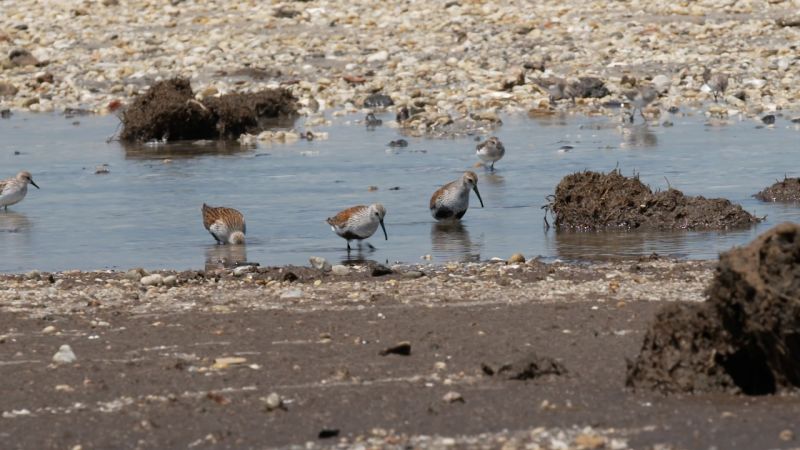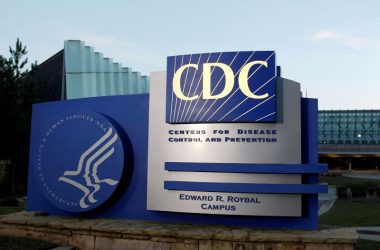First come the horseshoe crabs. Hoisting their round, tank-like shells, they trundle out of the Delaware Bay under the first full moon in May to mate and lay their eggs.
The birds soon follow. Hundreds of thousands of squawking, migrating shorebirds descend on these beaches to gorge themselves on the protein- and fat-rich eggs. Over the course of a week, some of the birds will double their weight as they prepare to resume their journeys between South America and their summer breeding grounds in the Artic. Up to 25 different species of birds stop here each spring.
It’s an ecological wonder not seen anywhere else in the world, and a bonanza for scientists who are looking to stop the next pandemic.
This year, their work has taken on new urgency as a dangerous flu virus, H5N1, tears through dairy cattle and poultry flocks in the United States. The world is watching to see if the threat will escalate.
The work at this beach could help make that clear.
“It’s a treasure trove around here,” said Dr. Pamela McKenzie, beckoning to her research partner, Patrick Seiler.
McKenzie and Seiler are part of a National Institutes of Health-funded team at St. Jude Children’s Research Hospital that’s been coming to the beaches near here for almost 40 years to collect bird poop.
The project is the brainchild of Dr. Robert Webster, a New Zealand virologist who was the first to understand that flu viruses come from the guts of birds.
“We were most amazed. Instead of in the respiratory tract, where we thought it was, it was replicating in the intestinal tract and they were pooping it out in the water and spreading it,” said Webster, who is now 92 and retired but still joins the collection trip when he can.
The poop, or guano, of infected birds is teeming with viruses. Out of all known influenza subtypes, all but two have been found in birds. The other two subtypes have only been found in bats.
On his first trip to the Delaware Bay in 1985, Webster and his team found that 20 percent of the bird poop samples they brought back with them contained influenza viruses, and they realized the area was an ideal observatory to track flu viruses as they traveled in birds along the Atlantic flyway, which runs between South America and the Artic Circle in northern Canada.
Finding a new flu virus here may give the world an early warning to incoming contagion.
The project has become one of the longest running influenza sampling projects of the same bird populations anywhere in the world, said Dr. Richard Webby, who has taken over the project Webster started. Webby directs the World Health Organization’s Collaborating Center for Studies on the Ecology of Influenza in Animals at St. Jude.
Predicting pandemics, Webby explains, is a little like trying to predict tornadoes.
“To predict the bad things, whether it’s a tornado, whether a pandemic, you’ve got to understand normal now,” Webby said. “From there we can detect when things are different, when it changes hosts and what drives those transitions.”
The US is in the midst of one of those transitions now. A few months before the St. Jude team arrived in Cape May this year, H5N1 had turned up for the first time in dairy cattle in Texas.
The finding that H5N1 could infect cows put flu experts, including Webby, on alert. Type A influenza viruses like H5N1 had never before spread in cows.
Scientists have followed H5N1 for more than two decades. Some flu viruses cause no symptoms or only mild symptoms when they infect birds. These viruses are called
low pathogenic avian influenzas, or LPAI. H5N1, which makes birds very ill, is called an HPAI, for highly pathogenic avian influenza. It devastates flocks of farmed birds like chickens and turkeys. In the US, infected flocks are euthanized, or culled, as soon as the virus is identified, both to prevent the spread of the infection and to mitigate the birds’ suffering.
It’s not the first time US farmers have had to contend with a highly pathogenic bird flu. In 2014, birds migrating from Europe brought H5N8 viruses to North America. Aggressive culling, resulting in the deaths of more than 50 million birds, stopped that outbreak and the US remained free of highly pathogenic bird flu viruses for years.
The same strategy hasn’t stopped H5N1, however. H5N1 arrived in the US in late 2021, and despite aggressive depopulation of infected poultry flocks, has continued to spread. In the last two years, H5N1 viruses have also developed the ability to infect a growing variety of mammals such as cats, foxes, otters, and sea lions, bringing them a step closer to spreading easily in humans.
H5N1 viruses can infect humans, but these infections don’t travel from person to person so far because the cells in our nose, throat and lungs have slightly different receptors than the cells that line the lungs of birds.
It wouldn’t take much for that to change, however. A recent study in the journal Science found that a single key change to virus’ DNA would allow it to dock onto cells in the human lungs.
The team at Cape May had never before found H5N1 in the birds they sampled there. But with the virus spreading in cows in several states, they wondered where else it might be. Had it reached these birds, too?
McKenzie and Seiler stepped gingerly onto the boggy beach this past spring in boots, gloves and face masks. Their pockets were stuffed with dozens of swabs they used to scoop fresh white guano out of the sand and deposit it into plastic vials they wedged expertly between their fingers. The vials went back into trays that got stacked neatly into a beige cooler Seiler hoisted onto his shoulder as he moved down the beach. Over the course of a week, the team would collect 800 to 1,000 samples.
Any flu viruses in the samples would be sequenced — the exact letters of the viruses’ genetic code would be read — and uploaded to an international database, a kind of reference library that helps scientists track influenza strains as they circle the globe.
The largest white droppings belonged to the seagulls — black-headed laughing gulls and white-headed herring gulls — McKenzie explained. The team planned to do a separate study focused on seagulls this year.
“There are some viruses that we’ve only found in gulls,” Seiler explained.
Some white splats, those that had visible lines of lumps of eggs still in them, belong to small birds called semipalmated sandpipers.
A few yards away, a fling of brown birds called dunlins was probing the sand for crab eggs with their long black beaks and nervously eyeing Seiler and McKenzie as the pair made their way down the beach.
Some of the samples they were collecting would be express shipped on ice back to Memphis, Tennessee, where St. Jude is located, but others would travel across town to an RV park, where Dr. Lisa Kercher was waiting for them.
Kercher, the director of laboratory operations at St. Jude, converted a typical RV into a mobile lab that was parked among other campers. This year, she was testing it out in the field to see if it could speed up the team’s work.
“We take samples in the field and we send them back to the lab and then we have an army of technicians that work diligently on these thousands of samples,” Kercher said. It can take months before the team knows the exact subtypes of the viruses they’ve found.
“If I’m here in May, for example, I will not know the subtypes of these viruses until September or October,” she said.
Kercher’s goal is to quickly screen the samples in the field to see if they contain influenza viruses or not. Each year, about 10% of the samples they bring back have flu viruses. If she could send only the positive samples back to the lab, they could be processed more quickly.
After fully sequencing the samples this year, they didn’t find H5N1 in either the Cape May samples or the duck samples from Canada.
“We don’t know exactly why,” Kercher said in an interview last week. “We’ve always been a little curious about that.”
After they finished in Cape May, Kercher drove the mobile lab to the Peace River in northern Alberta, Canada, to test ducks that would be breeding there over the summer. The team has made the trek to test ducks in Canada for 45 years, but this is the first year they used the mobile lab there. After the Alberta trip, Kercher drove her RV to Tennessee to test more ducks where they hibernate for the winter.
In the meantime, the virus was swirling all around them, popping up in herd after herd of cows in the Midwest and then California. Dozens of human infections in farmworkers had been reported, but the ones connected to dairy cattle had mostly been mild. No human-to-human transmission had been reported.
The cattle outbreaks seemed to slow briefly toward the end of the summer. Then came the serious human infections.
First, there was the teenager in Vancouver, Canada, hospitalized with respiratory distress. Then, more recently, a person in Louisiana became seriously ill with H5N1 after exposure to a backyard flock. In both instances, the virus was a slightly different type than the one circulating in cows. The virus identified in cows is from the B3.13 genotype, whereas the one found in both serious human infections is the D1.1 genotype, which has been circulating in wild birds and poultry, according to the US Centers for Disease Control and Prevention. There have been other cases of D1.1 infections in humans, too, in Washington state, in people who were assisting with a bird culling. Those cases were not as severe.
After missing the virus in the spring and summer, the the St. Jude team moved the mobile lab to a location they’d never tried before: a huge wintering ground for mallards and other ducks in northwest Tennessee.
They swabbed 534 ducks there in November and December and found the D1.1 genotype of the virus in about a dozen samples.
“We did get the same strain that’s causing all the havoc in the people and in the wild birds,” Kercher said.
D1.1 is a newer group of viruses. Scientists don’t know as much about it as they’ve learned about the cattle viruses. But the team’s samples, they said, have helped them connect the virus to the Mississippi flyway, which runs through central Canada, and follows the Mississippi River to the Gulf of Mexico.
Scientists don’t yet know when the strain emerged and began circulating as its own distinct type. Webby says they’ll be looking at the surveillance data they’ve amassed over the past year to try to figure that out.
The virus seems to be the product of a reassortment, where two viruses infect the same animal at the same time and swap genes. Reassortment viruses tend to have bigger changes to their genomes than viruses that change gradually as they get passed from animal to animal.
The surveillance data that the team collected recently contributed to a new preprint study, which was posted last week ahead of peer review.
The study was led by Dr. Louise Moncla, a scientist who studies the evolution of viruses at the University of Pennsylvania.
By analyzing surveillance data like the kind collected by Webby and his team, the Penn team found that the H5N1 outbreak that began in 2021 in North America was driven by eight separate introductions of the virus by wild, migrating waterfowl and shorebirds along the Atlantic and Pacific flyways.
Moncla and her team believe that the current outbreak hasn’t been stopped by aggressive culling, as it was in 2014, because wild birds continue to introduce it into populations of farmed and backyard flocks.
Sign up here to get The Results Are In with Dr. Sanjay Gupta every Friday from the CNN Health team.
They conclude that wild birds are an emerging reservoir for the virus in North America, and that surveillance of migrating birds is critical to stopping future outbreaks.
Webby and his team say they plan to continue their lookout. Come May, when the first full moon rises over the Delaware Bay, they’ll be back to do it all over again.
Kercher said what they found this year in the Delaware Bay was about what they’ve seen for the last 40 years: Shore birds are moving viruses around long distances.
“They stop in Delaware Bay to refuel, and then the viruses get moved around while they’re stopped over and then they carry it off again,” Kercher said.
There’s no way to know what lies ahead or whether the H5N1 virus will finally shape shift enough to become a danger to people. If it does, she said, they’ll be watching.





